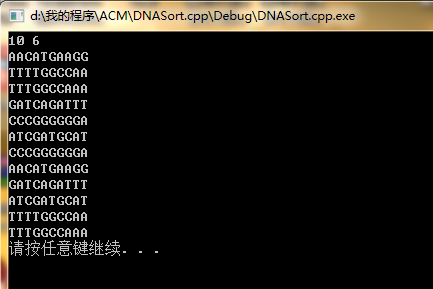Description
One measure of ``unsortedness'' in a sequence is the number of pairs of entries that are out of order with respect to each other. For instance, in the letter sequence ``DAABEC'', this measure is 5, since D is greater than four letters to its right and E is greater than one letter to its right. This measure is called the number of inversions in the sequence. The sequence ``AACEDGG'' has only one inversion (E and D)---it is nearly sorted---while the sequence ``ZWQM'' has 6 inversions (it is as unsorted as can be---exactly the reverse of sorted).
You are responsible for cataloguing a sequence of DNA strings (sequences containing only the four letters A, C, G, and T). However, you want to catalog them, not in alphabetical order, but rather in order of ``sortedness'', from ``most sorted'' to ``least sorted''. All the strings are of the same length.
You are responsible for cataloguing a sequence of DNA strings (sequences containing only the four letters A, C, G, and T). However, you want to catalog them, not in alphabetical order, but rather in order of ``sortedness'', from ``most sorted'' to ``least sorted''. All the strings are of the same length.
Input
The first line contains two integers: a positive integer n (0 < n <= 50) giving the length of the strings; and a positive integer m (0 < m <= 100) giving the number of strings. These are followed by m lines, each containing a string of length n.
Output
Output the list of input strings, arranged from ``most sorted'' to ``least sorted''. Since two strings can be equally sorted, then output them according to the orginal order.
Sample Input
10 6 AACATGAAGG TTTTGGCCAA TTTGGCCAAA GATCAGATTT CCCGGGGGGA ATCGATGCAT
Sample Output
CCCGGGGGGA AACATGAAGG GATCAGATTT ATCGATGCAT TTTTGGCCAA TTTGGCCAAA
Source
#include <iostream>
#define INF 0xffffff //定义最大地址
using namespace std;
char str[200][200]; //二维数组写入字符串每一个字符的值
int num[200]; //逆序数的值
int main()
{
int m,n;
memset(num,0,sizeof(num));
cin>>n;
cin>>m;
num[0] = INF; //初始化num[0]为最大地址,方便后来的选择排序法输出字符串数组
for (int i=1;i<=m;i++)
{
cin>>str[i];
//求出逆序数
for (int j=0;j<n;j++)
{
for (int k=j+1;k<n;k++)
{
if (str[i][j] > str[i][k])
{
num[i]++;
}
}
}
}
int p=0;
//选择排序法,输出字符串数组
for (int i=1;i<=m;i++)
{
for (int j=1;j<=m;j++)
{
if (num[j] < num[p])
{
p = j;
}
}
cout<<str[p]<<endl;
num[p] = INF; //将当前num[p]置为最大地址,方便下一个循环的比较
}
system("pause");
return 0;
}
